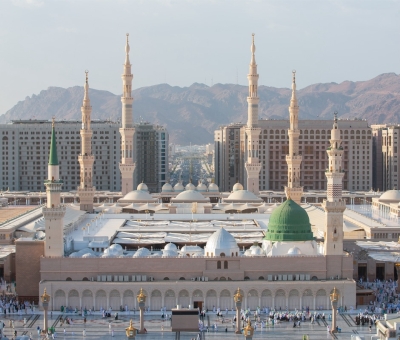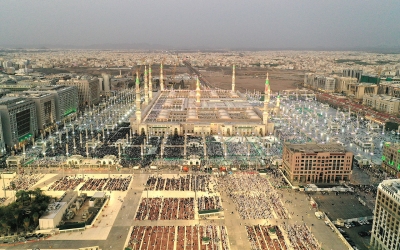
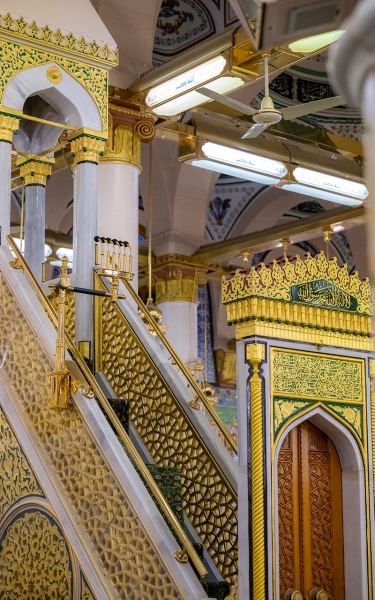
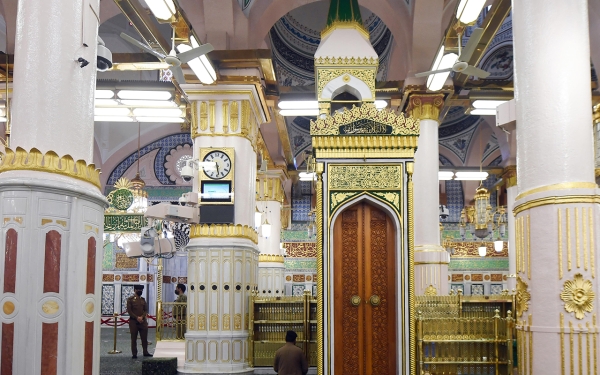
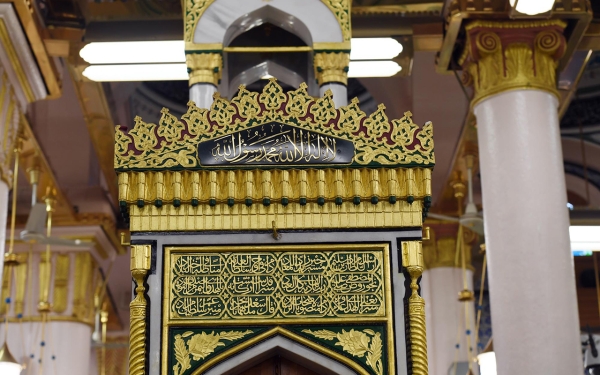
The minbar of Prophet Muhammed, blessing and peace of Allah be upon him, is one of the most prominent landmarks of the Prophet’s Mosque in al-Madinah al-Munawwarah. It is located on the western side of the prayer hall of the Prophet Muhammed, blessing and peace of Allah be upon him. The Prophet used to ascend it so that the Companions could see him while preaching. It was mentioned in its virtue that whoever swore an iniquity by the pulpit, would guarantee his seat in hell, and that between the minbar and the Prophet’s house is one of the gardens of Paradise, and that the minbar would be, on the Judgement Day, on the cistern of the Prophet, as it came in a number of hadiths “The area between my house and my minbar is one of the gardens of Paradise, and my minbar is on my cistern.”
The cause for its construction stemmed from the increasing number of worshippers at the Prophet’s Mosque during his time. Some were unable to hear or see the Prophet from a distance. Initially, he preached while standing beside a palm tree trunk within the mosque. Eventually, the idea of constructing a minbar emerged. This would allow him to ascend it, making him visible to the congregation, and also provide him with a place to rest and alleviate fatigue. According to prominent Sharia scholars like al-Hafiz Bin Hajar, the minbar of the Prophet (peace and blessings be upon him) was crafted by a carpenter named Maymoon. It was made from tamarisk or Tarafa wood and consisted of only three steps.
The sizes of the minbar of the Prophet Muhammed
The historian Ibn al-Najjar described the dimensions of the Prophet's minbar in his book "Al-Durrat al-Thameenah" in 1197, stating: "Its length is two arms and a span plus three fingers, and its width is a generous arm's length. The length of his chest, which the Prophet, peace be upon him, leaned on, is an arm's length. The length of the two handrails of the minbar, which he held with his noble hands when seated, is a span and two fingers."
The stages of the development of the minbar of the Prophet Muhammed
The minbar of the Prophet, peace and blessings be upon him, underwent several updates and improvements. Initially, it consisted of two steps and a seat. During the caliphate of Muawiyah Bin Abi Sufyan, may God be pleased with him, in the Umayyad state, Marwan Bin al-Hakam added six steps to it from its lower side, bringing the total number of steps to eight, with the ninth being the seat. However, the caliphs used to stand on the seventh step, which corresponds to the original first step of the Prophet's minbar in its initial construction.
When the caliphate transitioned to the Abbasid state, some of the caliphs initiated the renovation of the minbar due to its deteriorating condition. In 1256, the minbar was damaged by a fire that affected parts of the Prophet's Mosque. Its remnants were then placed on the bench, or the alabaster basin located beneath the minbar. The roof above the bench was subsequently bricked up until it became flat.
In 1258, King al-Muzaffar of Yemen sent a new minbar made of sandalwood to the Prophet’s Mosque, consisting of two columns. It remained in the same location as the previous minbar for ten years. Additionally, in 1266, al-Zahir Baybars al-Bandakdari sent another new minbar, which was used by the preachers of the Prophet's Mosque until the year 1395.
The minibars made by the princes for the Prophet's Mosque continued, and in 1395, al-Zahir Barquq sent a new minbar. Later, in 1417, al-Mu'ayyad Sheikh replaced Barquq's minbar with a new one, which remained in place until the Prophet's Mosque was burned down in 1481. In response, the people of Madinah constructed a new minbar using bricks.
Renovation of the minbar of the Prophet's Mosque in the Saudi Era
The Kingdom of Saudi Arabia has renovated the minbar several times, gilding it with gold and surrounding it with transparent sheets to protect it from contact with visitors, ensuring its longevity for the longest possible period.
Related quizzes
